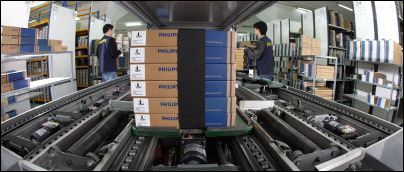The saying “eat our own dog food” is often used by technology companies to refer to the fact that they use the technology products they sell to customers in their own operations. Philips Semiconductors, one of the largest producers of RFID microchips, has decided to have a healthy helping of its own dog food.
Philips has announced that it has deployed RFID technology in its own supply chain to track boxes of microprocessors from its manufacturing and packaging facility in Kaoshiung, Taiwan, to its Asia-Pacific distribution center in Hong Kong. And Philips is considering rolling out the technology to other manufacturing facilities and distribution centers within its own supply chain.
“We decided to take [the RFID technology] we’ve been offering customers and use it internally to get the benefits ourselves,” says Dirk Morgenroth, RFID marketing manager at Philips Semiconductors. “Preaching about the benefits [of RFID] is one thing. Going through the experience [of deploying the technology ourselves] is another.”
About 18 months ago, Philips brought in IBM to provide consulting services and help Philips determine how the technology could be used to deliver a return on investment. A trial was launched in the second quarter of 2004 using RFID readers from Tagsys, a French RFID systems provider; labels from a Smartag, a Singapore company; and label printers from Zebra Technologies.
The pilot ran until November. Philips analyzed the results and worked with IBM to calculate the potential ROI. Based on the potential savings the RFID system can deliver, the company’s senior management recently made the decision to move from a pilot to deploying the technology throughout the Kaoshiung and Hong Kong supply chain operations.
Employees at the manufacturing facility in Taiwan pack microchips into boxes (known as “pizza boxes” in the industry because that’s what they look like) or in plastic tubes that are then placed in cartons. The Zebra printer prints a bar code on the label with an embedded RFID transponder and encodes a serial number onto the transponder.
Workers stack the boxes on a pallet and then use a handheld reader to read the tags on the boxes before they leave the facility for Hong Kong. When the pallet arrives at the distribution center in Hong Kong, the RFID tags on the cases are read with a handheld reader and inventory is updated automatically.
Philips is using 13.56 MHz tags with its own I-Code SLI integrated circuit. They conform to the ISO 15693 standard, have a read range of up to 1.5 meters (4.5 feet) and can hold up to 1024 bits of data. Staff at the distribution center typically break down a pallet and create shipments for specific customers. Using their handheld readers, they encode each box’s RFID tag with information about the customer to which that box will be shipped. When the shipment is sent out, the tags are read again to make sure the order is correct and the cases are bound for the right customer.
Philips is talking to customers about receiving tagged shipments and sharing the data to determine the benefits that RFID can deliver to both Philips and its customers. Morgenroth says Philips is considering using Electronic Product Codes on the tags when customers are involved, so that data associated with a shipment can be stored in a secure database and that both Philips and the customer can share access to the database for better supply chain coordination.
For competitive reasons, Philips is not saying how much it is investing in the rollout or what it expects the return on investment will be. But Morgenroth says that the trial showed that the use of RFID reduced the amount of labor needed to pick cases for an order by 25 percent, and it reduced the time it took to receive shipments into inventory and process outbound shipments by 50 percent each.
Semiconductor companies have used RFID technology for several years to track the location of wafers within their manufacturing facilities. But this is the first large-scale deployment of the technology in the supply chain. Morgenroth says Philips will track several million boxes per year moving between the Kaoshiung and Hong Kong facilities. If the technology is rolled out throughout Philips semiconductor supply chain, it would cover upwards of 100 million boxes per year. And that’s a lot of dog food.



